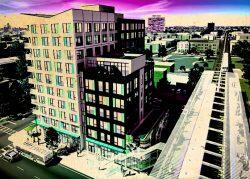Chicago Mayor Lori Lightfoot has transportation on her mind – and the hope of pushing more developers to plan projects near major hubs.
“It makes it easier for residents of that housing to access jobs, schools and more while saving thousands of dollars in household transportation costs,” she said last week at a topping-off event for Bronzeville’s 43 Green, the first phase of a $100 million mixed-use project built around the 43rd Green Line Chicago Transit Authority stop.
43 Green is a visible reminder of the city’s “Connected Communities” ordinance, passed last week by the City Council, that aims to boost investment and access to affordable housing on the city’s South and West sides by allowing developers to build denser near transit hubs. Expanding an ordinance passed almost a decade ago and updated incrementally since then, it extends the geographical range of the city’s incentives.
Building near transit is a “critical strategy to keep Bronzeville an economically diverse and attractive neighborhood, said P3 Markets Principal Phil Beckham, who is developing 43 Green along with The Habitat Co. The project will offer 50 affordable housing units and 49 market-rate ones with direct access to downtown via the Green Line.
Under the ordinance, developers can build with an increased floor area ratio, which compares total floor area with the size of the land on which it’s built. Other incentives include a reduced minimum lot area, meaning developers may build more dwelling units on a particular parcel, and increased maximum building height. All those lead to higher profitability.
Qualifications include building no more than one parking space per dwelling unit. Also, for each additional unit built, the developer must include an affordable unit.
The ordinance makes those incentives available to development within a four-block radius – up from two blocks – from bus and rail stations and two blocks from “high-frequency and strategic bus corridors,” according to the city.
Since the city first adopted its 2013 “Transit Served Location” ordinance, the majority of the development spurred by that legislation has bypassed the city’s South and West sides, according to the ordinance, supported by Beckham and Habitat’s Charlton Hamer.
The development is the neighborhood’s first that’s part of Chicago’s Equitable Transit-Oriented Development Pilot Program, which grew out of the city’s eTOD Policy Plan. The ordinance implements a number of recommendations from that plan.
Another city that has recently made an effort to prioritize transit-oriented development is Riverhead, New York, is making moves to revitalize the area around its train station.
Read more


– Rachel Herzog
